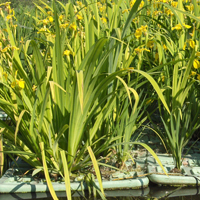Ornamental plants for floating treatment wetlands: preliminary results

Accepted: 28 March 2020
HTML: 76
All claims expressed in this article are solely those of the authors and do not necessarily represent those of their affiliated organizations, or those of the publisher, the editors and the reviewers. Any product that may be evaluated in this article or claim that may be made by its manufacturer is not guaranteed or endorsed by the publisher.
Floating treatment wetlands (FTWs) represent a novel ecotechnology for the treatment of different types of wastewaters in natural or artificial water bodies, through the use of traditional rooted emergent macrophyte species supported by floating rafts. Although many studies have reported the treatment performances of FTWs, showing an excellent aptitude for removing nutrients, heavy metals as well as suspended solids, the investigation of vegetation has not received much attention up to now, especially for herbaceous ornamental plant species that could form an interesting opportunity to improve water quality and the esthetic-ornamental value of urban water bodies. For this reason, a pilot scale FTW was installed in Northern Italy to assess the growth performances of eleven wetland species having ornamental features: Canna indica L., Pontederia cordata L., Thalia dealbata Fraser ex Roscoe, Acorus calamus L., Juncus effusus L., Iris laevigata L., Mentha aquatica L., Oenanthe javanica (Blume) DC., Caltha palustris L., Sparganium erectum L. and Zantedeschia aetiopica (L.) Srengel. For these species, a suitability index was elaborated that considers plant survivability, above-mat biomass production, nitrogen uptake, root length and root-shoot ratio. On this basis, the results obtained clearly indicated that C. indica, P. cordata and T. dealbata were the most suitable species for FTW due to their high vigor and colonization of the floating mats (1638.9 g m–2, 483.4 g m–2, 566.1 g m–2 of above-mat dry biomass, respectively; 38.8 cm, 62.0 cm, 43.8 cm root length, respectively; 0.8, 0.9, 1.2 root-shoot ratio, respectively), survival (100%), nitrogen uptake (15.1 g m–2, 15.0 g m–2, 15.7 g m–2 respectively). On the contrary, A. calamus, S. erectum and Z. aetiopica did not present adequate features for use in FTWs.
Highlights
- Floating wetland represents a valid alternative to improve the quality of urban water bodies and their aesthetic-ornamental value.
- Canna indica, Pontederia cordata, Iris laevigata, Caltha palustris and Thalia dealbata excellently survived in the floating system.
- Zantedeschia aetiopica and Sparganium erectum were not suitable to survive under hydroponic conditions.
How to Cite
PAGEPress has chosen to apply the Creative Commons Attribution NonCommercial 4.0 International License (CC BY-NC 4.0) to all manuscripts to be published.

 https://doi.org/10.4081/ija.2020.1602
https://doi.org/10.4081/ija.2020.1602



